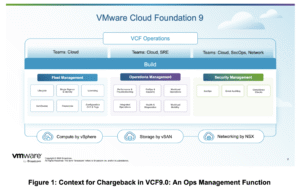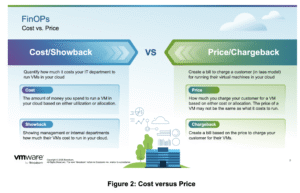As part of the July 2025 Tech Field Day presentations around VMware Cloud Foundation 9.0, VMware’s Kyle Gleed and Kelcey Lemon walked the delegates through VCF 9.0’s new Ops features in Fleet Management and Chargeback.
This is a companion post to two other pieces I wrote (along with many from the other delegates), and as always, I try to focus on items that are relevant or at least interesting to network operators. It’s not intended to be a webinar play-by-play, but focuses on the questions I asked, the answers I heard, and other network-adjacent topics.
Chargeback for Networks
The features in VCF 9.0 for showback and chargeback make so much sense. You have the tools to show tenant organizations what private cloud resources they’re consuming. If you have internal billing, you can use that info to bill for usage.
What if you could hand each tenant org a “bill” for their network usage – bandwidth, premium path reservations, QoS consumption – and have them optimize based on cost? In VCF 9.0 Ops, chargeback does exactly this for compute, storage, and network services inside the private cloud. It’s not a huge leap to imagine it for tenant network usage.
Chargeback Mechanics in VCF 9.0
Kelcey Lemon demonstrated how VCF 9.0 now integrates chargeback into the Ops and Automation consoles:
- Rate Cards: Define prices for compute, storage, and network metrics
- Per-Org/Region Projects: Break costs down by tenant or business unit
- Real-Time Showback: Teams can log in anytime and see costs to date
- Billing Automation: Schedule invoices or generate on demand
This is all built on VCF’s FinOps philosophy—merging financial and operational data to drive transparency and accountability for private cloud usage.
The Networking Case
In networking, we already measure or have the capability to measure things like:
- Connection speeds / port types for physically connected customers
- Bandwidth per tenant, per app or service, per site
- Prioritized traffic
- BGP peering sessions and VPN tunnel counts for managed customers
With the right understanding of workflows and how much effort they take, we could assign a cost to each, similar to VCF. Showback could educate teams on what their footprint really costs. Chargeback could recover costs, fund upgrades, and maybe even be a revenue generator in the right circumstances.
Business Perspective for Network Infrastructure
In short, many network teams don’t typically think about network costs this way. And many more NetOps teams generally don’t think in financial and business terms. This is a good opportunity to add financial perspectives into your repertoire; seeing who gets charged the most, whether you actually bill for service or not.
Network Automation Alignment with Costs
There is an interesting point of alignment with shops that are driving and maturing the level of network automation in their infrastructure. To measure effectiveness of automation efforts, some assign costs associated with specific workflows so they can get a sense of cost and effort saved through automation and orchestration. This same cost data can be used as input into costs imposed on users. So if you’re driving automation initiatives in the network, consider this methodology of assigning workflow costs, and see if this data could help you identify per-tenant usage costs.
Implementation Considerations
I wouldn’t recommend that you go straight to charging. Some period of time on the order of 6-12 months of showing internal customers their usage would be good to show them what they’re using, give them time to adjust, and prepare for the next budget cycle to be ready for network services billing.
Other Networking Impact Points
Kelcey pointed out a few other important details around other network impact issues:
- Observability Traffic – Ops Collectors now carry log data as well as metrics. It’s sustained and bursty traffic; plan accordingly. Those Ops Collectors can also forward on traffic, so they are now in the data path in a way they were not in previous releases.
- Latency Budgets – VMware’s ≤100 ms and ≤500 ms RTT guidelines mean network topology is part of the deployment plan.
- Policy Alignment – Just as you’d align ACL/QoS across routers, align cost and consumption policies across compute, storage, and network services.
Why This Matters
If networking teams could adopt a chargeback/showback mindset, we could see the following:
- Fewer “free” overprovision requests – thinking first before requesting resources
- More realistic network capacity planning
- Data-driven funding for network upgrades
- Deeper understanding of the business side of networking for your entire team
VCF 9.0 doesn’t give us network chargeback out of the box, but it models how it could work, and how it might be received.
Bottom Line
Chargeback drives accountability in private cloud consumption. For NetOps, this is both inspiration and a roadmap for applying similar principles to the network domain.
The VMware Cloud Foundation 9.0 Showcase: Powering the Modern Private Cloud was presented by VMware in association with Techstrong and Tech Field Day. The videos will be posted to the Tech Field Day YouTube channel and on the website. You can learn more about VMware Cloud Foundation 9.0 on the VMware website.



